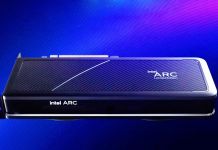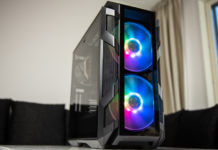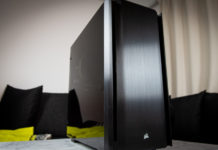Antec Performance One Mini P180 is a new case of the Performance One series. A series which has been showered with praise, and today we will see of it’s possible to shrink the two-chamber design to mATX standards.
In the past we’ve looked at both the Antec Performance One P182SE and P190, along with some competing cases targetting the same crowd of consumers. These are all quite large midi-towers or full towers, and when I heard that Antec was working on a mini version of the P182 I just had to have it. There was no discussion to be had.
I talked to Antec and they were more than happy to send one over. The first thing that struck me was that Mini P180 is a lot smaller than I first thought. I didn’t think you could shrink P182 this much. When looking at pictures from events and at Antec’s website, it looks just slightly smaller than P182, but it’s actually a lot smaller.
I was a bit skeptical at first as to whether the dual chamber design would be practical in a mATX format, mainly because it’s built on the principle of space and good air flow. Will it really work as intended when you minimize the amount of free space?
That’s what we’re here to find out.
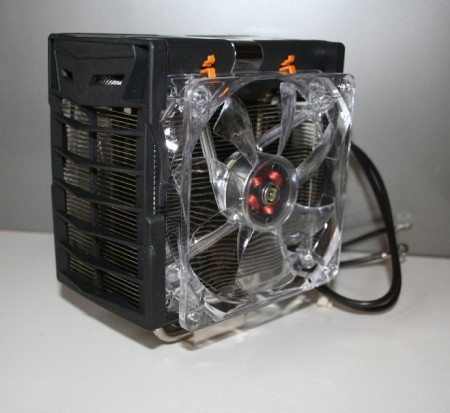 |
|
|
Antec Performance One Mini P180
|
|
| Case: | Microtower |
| Side panel: | – |
| Measurements (HxWxD): | 43.5×21.2×43.6cm 17.1″x8.3″x17.2″ |
| Weight: | 20.9lbs / 9.5kg |
| Motherboard support : | mATX |
| Cooling (fans): | Rear – 120 mm Roof – 1 x 200 mm Front – 2x 120 mm (not included) |
| Material: | Side panels made from triple-layer: plastic – aluminum – plastic Frame made from 0.8mm stainless Japanese steel |
| Internal units: | 6×3,5” |
| External units: | 3×5.25” |
| Expansion slots: | 4 |
| Power supply | – |
| Color: | Black or White |
| Other: | Detachable harddrive bays USB, eSATA, mic and headphone connectors in the front Compartment for storing screws, etc.. Two-chamber design Rubber dampening throughout the case Screws and extra brackets for the harddrives, optical units and fans. Removable and washable dust filters Cable ties Manual 3.5-5.25″ adapter |
| Price: | ~$130 |
We’re looking at the result from a true challenge here today. Mini P180 has many of the Performance One series features, such as the two chambers, the logical fan locations, the overall flow design, removable drive bays and so forth, but all much tighter together. Can you do that and still get the renowned quiet and cool interior of the Performance One series?
As you can see from the specifications, this is a quite rich case even though it’s small. Six 3.5” slots and three 5.25” bays. Although, I can’t for the life of me understand why companies keep having so many 5.25” drive bays when no one uses them. Three is acceptable though, two would’ve been more than enough. As you can see there is no external 3.5″ slot, but if you’re one of the few people who still use a floppy drive there’s an adapter to install one in one of the 5.25″ slots.
The Mini P180 has inherited the three-layer side panel design from the other P18x models, which eliminates all noise coming from the components inside the case. Rubber suspensions can be found everywhere you need them; the drive bays and the power supply are fully supported by rubber pads. The fans have controllers that can be accessed from the rear of the case.
The case has two fans from factory. One in the roof of the case and one in the back. The one in the back measures 120mm and the one in the roof 200mm. Both are of the Antec TriCool series. Specifications are as found in the table below;
|
Antec TriCool 120 mm
|
|||
|
RPM
|
Airflow (CFM)
|
Noise (dB(A))
|
Power (W)
|
|
2000
|
79
|
30
|
2.9
|
|
1600
|
56
|
28
|
2.4
|
|
1200
|
39
|
25
|
1.6
|
|
Antec TriCool 200 mm
|
|||
|
RPM
|
Airflow (CFM)
|
Noise (dB(A))
|
Power (W)
|
|
800
|
134.1
|
29.4
|
3.6
|
|
600
|
108.5
|
26.5
|
2.04
|
|
400
|
82.6
|
23.6
|
0.96
|
Both of these have washable dust filters and can be controlled via the panel on the back of the case. We still stick by recommending the lowest setting. It’s more than sufficient in airflow and will produce the least noise. You can install two more 120mm fans in the front of the case to cool your harddrives.
Along with the accessories above, there’s also a manual, which contains pretty much everything you need to know about the case and how to install various components.
Here you see the Mini P180 next to the previously reviewed Antec P182 Special Edition. I was surprised by the size of it, it looked bigger on the pictures I’ve seen on the net. We should mention that the P180 Mini is also available in white.
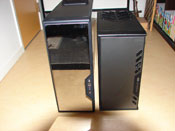 |
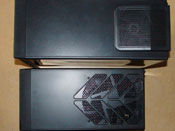 |
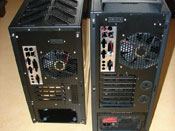 |
If we’re to say anything about the design of the Mini P180, it’s that Antec has chosen to move away a bit from the otherwise so clean design. Why that is, we have absolutely no clue, but it’s really not as bad as some of the pictures makes you think. The air holes on the front somehow seem to get enlarged by the camera. They’re not so bad in real life. The same goes for the air filter on the top. It’s dull black and blends into the overall deign quite nicely.
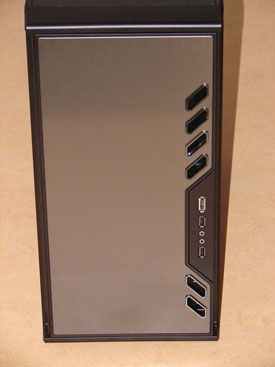 |
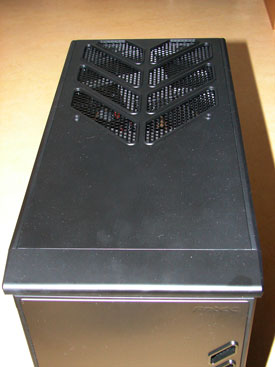 |
The door is pretty much the same as with previous [fixed] models. It opens 180 degrees and even though it’s plastic, it’s rigid and won’t bother you that much. On the front you will find two USB ports and one eSATA port along with audio in and out jacks.
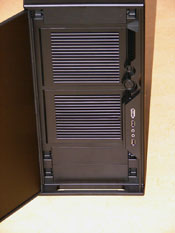 |
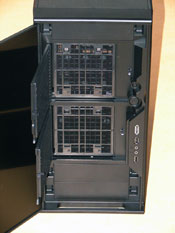 |
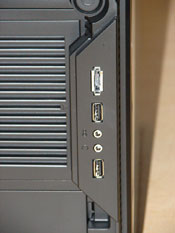 |
Just like the P18x and P190 models, Mini P180 is larger than most other cases of its size segment. There are smaller mATX cases on the market, but we still have a bit to go before we can decide if the extra centimeters here and there are worth it.
The back looks just like any other Performance One case, just smaller. The power supply goes in the bottom chamber, above that you have the rear 120mm fan and above it, the two controllers for the rear and top fan. No holes for pulling water cooling though, which is a bit understandable though as the case is already crowded as it is, without a water cooling kit inside.
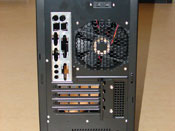 |
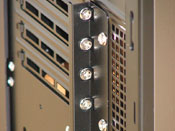 |
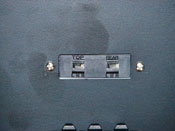 |
|
Excuse the fingerprints. REAR is now spelt correctly
|
||
This is where the Mini P180 is the most interesting. Shrunk to mATX format, it gets a lot tighter inside. Unfortunately we didn’t have a mATX motherboard to play with here, but if you look at where the holes for the stand-offs are located you can see that such a motherboard will fit by the edges.
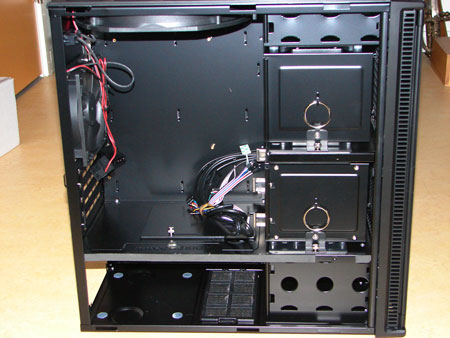 |
It would have been nice with ITX and flexATX support as well.
Much like the big brothers of the series, Mini P180 has two harddrive bays. One which has the drive lying down and where the drives are mounted onto sleds before inserted into the bay, and one where there drives are slid into the bay and attached standing on the side (this will not affect performance or in any way increase the chance of a crash). One of the bays also has a compartment for storing screws and other things. Very handy for storing screws and other small stuff.
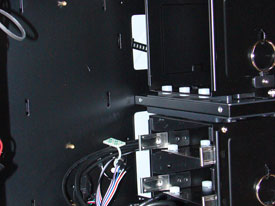 |
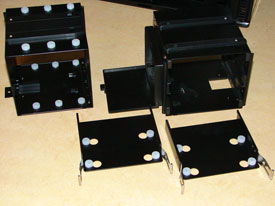 |
The three 5.25” slots have been spilt up between the two chambers. Two are located in the lower chamber and one at the top of the upper chamber. We have reason to believe that the latter is the only one which is actually going to be used. Any 5.25″ unit you want to install will have to be fitted with the supplied rails to slide into the slots. When there, they will sit firmly and is easily be removed and upgraded when needed to.
A drawback with this design is that all harddrives are now located in the upper chamber and that the lower chamber somewhat loses its original purpose. The power supply is still separate from the rest, but Mini P180 has no fan for cooling the power supply or the additional 5.25” units. With previous models you’ve been able to split up the harddrives among the two chambers and avoid them warming each other. And if you install two 5.25″ drives in the lower chamber, there will be no air flow for the power supply.
You don’t have to worry about long graphics cards. You can make room for them.
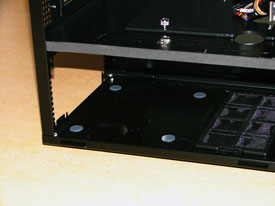 |
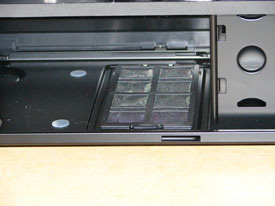 |
Of course, you can always use the 5.25-3.5” adapter and mount one of the harddrives in the lower chamber anyway. And I’m guessing the reason Antec designed it this way was because they wanted to make parts, and drive bays specifically, compatible between models to reduce manufacturing costs. A sensible move, which will also make it easier to replace broken parts. Not that I have ever heard of anyone managing to break one of the drive bays, but still. Putting one of the drive bays in the lower chamber would also increase the size of the case.
The cable management is the same as it is with the P182 model, which makes us wonder why Antec didn’t name it Mini P182. It doesn’t really matter though, because the cable management system with Mini P180 is excellent and you can easily hide any excess cables behind the motherboard tray.
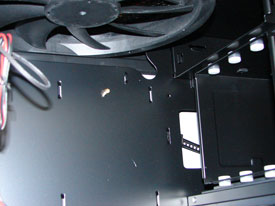 |
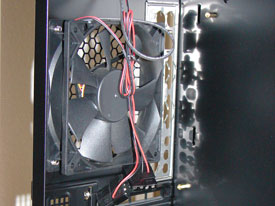 |
One thing that surprises us is that there is no hatch to open and slide in the power supply through. Instead you have to slide it in from the side. May be for the better when everything comes around, but still surprising not to see it when the bigger brothers does have this feature.
Antec P180 Mini has some tough shoes to fill, not only because it follows in the footsteps of some of the most critically acclaimed cases ever released, but also because Antec has tried to readapt a theory and concept that was originally conceived for a much larger case.
While we’re certainly impressed by the overall design and quality of Performance One Mini P180, it’s not a perfect shrink of the bigger brothers. However, I do believe that this is the closest you can get with Antec’s award-winning design in a mATX format, withouth the price skyrocketing due to the need of new drive bays and more fans. Antec has considered those who want to use full-size graphics cards and made it possible to adapt the interior so that these will also fit inside the Mini P180.
Antec has made a serious attempt to bring the two-chamber design and the remaining acclaimed features of the Performance One series to the mATX market through the Mini P180, and it has succeeded, even though it has had to make a few compromises. We would also have liked suppport for more formfactors, for example the ITX standards and flexATX. We would’ve preferred one harddrive bay in the lower chamber and fewer 5.25″ overall, but that might have result in the case being even bigger.
Our overall impression of the Antec Performance One P180 Mini is that it is indeed a great case and that it is a worthy member of the Performance One series. The aestethics are all there and the fans are fairly quiet. The cooling potential is superb. The price is in the expected range and we can really recommend this case to anyone who is looking for a mATX case, and want lots of harddrive bays and an overall cool and quiet computer.
 |
|
Antec Performance One Mini P180
|
|
Pros Cons |


